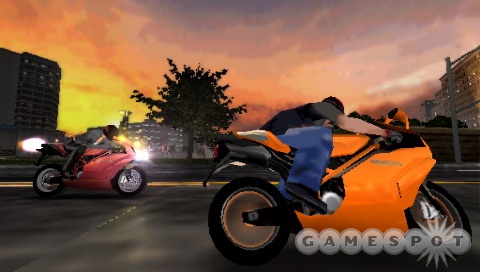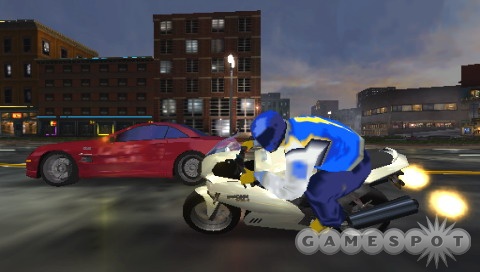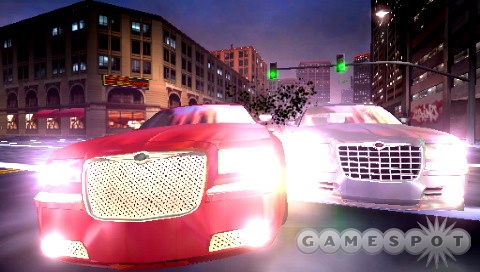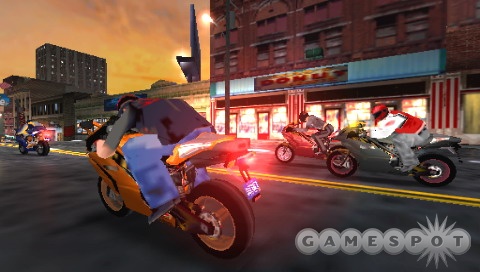Rockstar Games released Midnight Club 3: DUB Edition a couple of months back to both fan and critical acclaim. Eschewing the overly commercialized, hokey, and downright stereotypical stylings of the street racing genre, it was a most welcome offering. Now, developer Rockstar Leeds has cranked out a PSP iteration of its console racer and has managed to cram nearly the entire scope of the console game onto one of those tiny Universal Media Discs. Unfortunately, a few serious liberties had to be taken to make that happen. Some ugly load times, minimal damage modeling, a few periodic sound bugs, and one unpleasant frame rate all conspire to make the PSP version of Midnight Club 3 a weaker overall effort. Sure, it's still a mostly fun and sometimes exciting street racer, but when put up against competition like Ridge Racer and Need for Speed Underground Rivals, it seems a lot more ordinary.

Like the Midnight Clubs before it, Midnight Club 3 offers up a huge, open-ended city for you to race in. Well, there are actually three cities. You'll begin in San Diego, but you'll eventually be able to open up the cities of Atlanta and Detroit as well. Unfortunately, it takes an exceedingly long time to load up each of these cities--upward of 70 seconds in most cases. The in-game loading times are also annoying. During gameplay you often have to switch between racing, cruising, and visiting the local garage, and jumping from spot to spot always results in some lengthy loading. The console versions weren't exactly quick when it came to in-game loading, but they were an absolute breeze compared to the PSP iteration.
Each city is chock-full of back alleys, hidden shortcuts, and special jumps that you'll be hard pressed to discover until you've spent ample time driving around. Thankfully, the game provides a cruise mode where you can just drive and explore, which isn't nearly as boring as it sounds, because there are also some hidden Rockstar logos strewn about that will earn you goodies when you collect them all. It's also useful to get familiar with all the nooks and crannies of the city, as knowing your way around is immensely beneficial come race time, since most of the races in Midnight Club 3 are checkpoint races. These checkpoints are scattered all over the place, and oftentimes there are multiple paths that will take you to each one. Half the challenge of the game is trying to find the best path to each checkpoint. The one problem with this methodology is that it can be quite frustrating the first few times you engage in a particularly challenging race because you won't know where all the required turns and potential obstacles are. This leads to a fair amount of trial and error that isn't altogether detrimental (especially since using the free-roaming mode gives you a good idea of how the city is laid out), but it definitely has its annoying moments. Fortunately, there are also point-to-point races and timed races to provide some variety to the action, and they're far less taxing to boot.
Midnight Club 3 is an arcade racer through and through. If you're looking for even a modicum of realism from this game, you might as well forget it. The physics are geared toward big jumps, taking tight corners at ridiculous speeds, big, exaggerated crashes, and frenetic action. The controls are generally tight and easy to pick up, though it will probably take you at least a little time to get accustomed to the different car classes. With more than 60 licensed cars available, there's a lot to choose from, including tuners, muscle cars, trucks and SUVs, motorcycles, and luxury automobiles. H2 Hummers, Cadillac Escalades, Mitsubishi Lancers, '64 Chevy Impalas, and Kawasaki Ninjas are just some of the many vehicles you can race with. Though nearly all the cars are fast and loose, every car type has its own strengths and weaknesses, which come in to play with the game's unique special moves system.
Yes, that's right. The cars in Midnight Club 3 actually have special moves. While that might sound a little wacky, it's not so bizarre. There are three types of special abilities assigned to the car classes. Big, intimidating cars can use an ability that knocks all the traffic around you out of your way; others can use an "agro" ability to inflict extra damage to cars you hit; and the speedier vehicles can use an effect that slows down time, letting you simply maneuver around any traffic that gets in your way. These abilities are handy, though perhaps not as well implemented as they could have been. The slow-down ability, for instance, slows down time almost too much, and it doesn't last long enough to be useful. Similarly, the intimidation ability the big vehicles use sometimes doesn't do anything except push the car in front of you farther ahead. Still, when the abilities do work, they're satisfying. And when you couple them with the preexisting nitrous and slipstream speed boosts, things can get pretty crazy.
Perhaps the best thing about Midnight Club 3's racing is that the difficulty never feels artificial. If you wreck once, or even twice, you still have a perfectly solid chance to catch up and win the race, as your opponents are prone to wrecking and spinning out as well. Similarly, if you catch the lead and can avoid wrecking or doing anything stupid, your opponents won't just magically overtake you.

The bulk of the offline racing you'll be doing in Midnight Club 3 will likely be in the robust career mode. You begin with about 20 grand in your pocket and an introduction to a local garage owner, who sets you up with a ride of your choice and an "in" to the underground street racing scene. Make no mistake, if you're looking for some kind of dramatic tale of intrigue or anything involving a lot of interaction with your typically stereotyped street racing characters, you won't find either here. The career mode focuses squarely on the racing, which is a welcome change from the hackneyed attempts at driving game stories that other similar games have tried.
There are multiple types of races to engage in during the career mode, all of which are structured around the basic checkpoint, point-to-point, and time trial races available throughout. Basically, you start by getting together with various hookmen who will challenge you to a short series of races. Impressing them will get you shots at longer series of races with assorted car clubs, each of which revolves around specific car types. So if there's a club that races with nothing but trucks, you'll need to have a truck or an SUV in your collection to participate in the races. While this might seem like a chore, it isn't, thanks to a number of tournaments that seem to ever so conveniently pop up right around the time a new car club challenges you. In these tournaments, you can win new cars. And they're almost always the precise kinds of car you need to move forward. Apart from all these main races, there are a number of side races available in each city that don't help your career but do provide you with extra cash. That's good, because you'll need it to fully trick out your whip.
The car-customization element of Midnight Club 3 is possibly its best feature, despite not being terribly complex. For under-the-hood improvements, you begin with a stock part for everything ranging from suspension systems, to brakes, to exhaust systems, to nitrous boosters, and more. As you play, new upgrade parts will be shipped to your local garage, and you can buy them for boosts to your car's acceleration, top speed, and handling ratings. Of course, this wouldn't be a proper street racing game if it didn't provide you with plenty of gaudy ways to customize your car on the outside as well. Body kits, decals, custom paint jobs, $20,000 rims... You name it, you can throw it onto your car. Unfortunately, these types of customizations don't have any effect on your car's performance, so you'll be spending your cash on something that's designed for pure aesthetic value. Fortunately, it's pretty tough to go broke in the game, so you'll rarely be strapped for cash, even if you want all your cars to be sitting on 20s.

The customization aspect of the game is where the subtitle "DUB Edition" comes in to play, as all the brands and styles of parts were included on the recommendations of the folks behind DUB Magazine. In fact, they apparently played a part in car selection as well. While it might seem like this could turn into bad advertising for the magazine very quickly, it thankfully doesn't. You'll see the DUB logo pop up on occasional license plates and specialized cars, but it's never intrusive.
The career mode is quite a lengthy affair, so it could take you upward of 18 to 20 hours to complete, depending on how well you perform. However, it's hardly the only mode you'll have to mess around with. Midnight Club also includes an arcade mode that's filled with all the career mode's single-player races, as well as a bunch of multiplayer races. These multiplayer races are a little quirky, with some variations of capture the flag, tag, and paint games. Admittedly, these games are on the gimmicky side and aren't much fun for more than a few plays each, but with so many different regular races to take part in, you're unlikely to run out of stuff to do anytime soon. Incidentally, the only multiplayer functionality Midnight Club 3 features is Wi-Fi, and you won't be able to play online. However, up to six people can play over the Wi-Fi connection, provided each has a copy of the game.
One of the best features of the console versions of Midnight Club 3 that is regrettably missing here is a sense of speed. On the Xbox and PS2, the game was incredibly brisk, with minimal frame rate issues and a great motion-blur effect that made everything feel extremely quick. Sadly, that isn't the case here. The base-level frame rate isn't very good, and it chops up in certain situations. Further, the motion-blur effect is pared down a lot, which makes the game feel a lot slower than it should. While it's understandable that a certain level of trade-off was going to be required to squeeze a big console game onto the PSP, the lack of a sense of speed is a major hindrance. On the plus side, the city environments look nice as you drive along, and the car models are nicely detailed (although the damage modeling, which was kind of scarce to begin with, is almost entirely absent here).
The audio in the PSP version is also less impressive, with more-repetitive sound effects and a few glitches here and there. Tire screeching, crashing, and other car noises sound a lot more similar to one another in the PSP version, to the point where you feel like you're hearing the same audio file over and over again. Also, some sound effects will randomly cut out, such as when you're trying to burn your tires before a race starts. The sound itself won't even start until halfway through the three count. The rest of the audio is just about as good as the audio in the console games. The voice acting is still a touch cheesy, but there isn't a ton of it, and the soundtrack consists of a huge roster of hip-hop, rock, dance hall, and electronic artists, including such name acts as The Game, M.I.A., Kasabian, Queens of the Stone Age, Beenie Man, Nine Inch Nails, the Ying Yang Twins, and Jimmy Eat World. Some of the genres are a little pervasive (translation: a little too much dance hall for the game's own good), and there are a couple of weird song choices (like the oddly timed inclusion of Marilyn Manson's "Rock Is Dead"), but all told, it's a great soundtrack. Plus, while in a race, you can separate the soundtrack by genre if you like.

While PSP-owning street fans will likely find Midnight Club 3 to be a genuinely enjoyable game, there's no denying that it feels like a missed opportunity, overall. It seems like Rockstar Leeds was just a touch too obsessed with trying to get the full scope of the console game onto the PSP, and in the process, it had to make a few too many sacrifices in the name of its cause. Some things are forgivable, but the protracted load times, sputtering frame rate, and unimpressive sense of speed all combine to drag down what could have been a great game. The gameplay is still more than solid, however, and the deep career mode should keep PSP players entertained for a good long time. All told, it's a flawed but fun street racer, and genre enthusiasts will certainly enjoy it on some level.